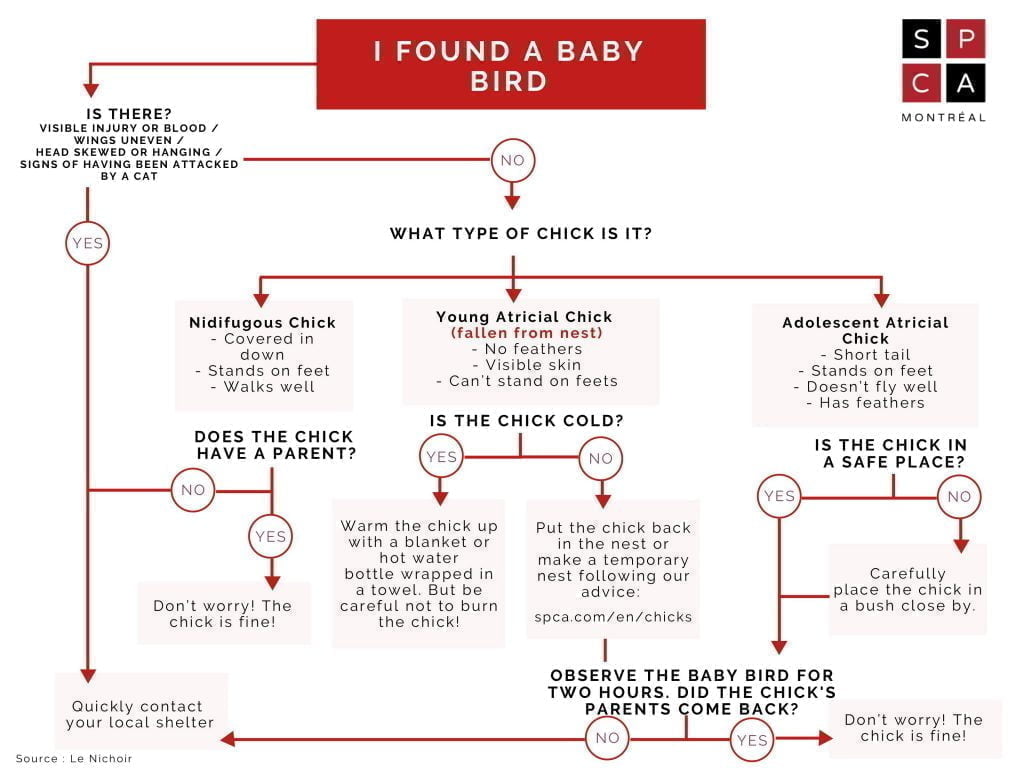Did you find a chick that seems distressed? Before doing anything, it’s important you figure out the type of chick to know if the bird really does need your help.
Nidifugous chick
– Covered with down
– Stands on feet
– Walks well
Nidifugous chicks leave the nest quickly and are able to walk within hours of hatching. They are always accompanied by a parent. This is the case of ducklings, for example.
Atricial chick:
– No feathers
– Visible skin
– Can’t stand on feet
Atricial chicks are usually in their nest or should be.
Adolescent atricial chick
– Short tail
– Stands on feet
– Doesn’t fly well
– Feathers all over the body (except sometimes on the head)
Adolescent atricial chicks have just left the nest to learn various skills, including flying. Their parents are watching from a distance and will not approach if they perceive a human nearby.
Note: Since large, baby crows can be told apart from adults by the colour of their eyes, which vary from light blue to grey.If the crow has bright eyes and looks healthy, don’t worry. Their parents are looking after them!
Should I do something?
Once you’ve identified the type of chick you’ve found, use the flowchart to see if it really is necessary you do anything. Unless seriously injured or in exceptional circumstances, baby birds are always best left with their parents, who know how to take good care of them!

A few tips
Building an artificial nest.
If you aren’t able to put a baby bird back in their nest, make them a new one. Poke small holes in the bottom of a plastic container for drainage and fill it with grass, leaves or toilet paper to keep the chick comfortable.
Then, securely tie your nest to a branch, out of the sun and away from children and other animals, as close as you can to where you found the baby bird. Observe the chick for at least two hours to see if the parents come back or if the baby bird has been abandoned. Be attentive. Birds are very quick and sometimes only come back for a few seconds!
Touching a chick
It isn’t true that birds will reject a chick who has been touched by a human. Since birds have a poorly developed sense of smell, they actually won’t even notice! So, you can gently put a chick back in the nest if the situation truly requires (see the flowchart).
But careful: Don’t ever handle a chick unnecessarily. The stress of being handled could be fatal for the baby bird!
Feeding a baby bird
Do not feed or give a chick water or milk. If the baby bird truly needs your help, contact your local shelter, which will be able to provide the necessary care and proper feeding.
Warming a baby bird
If the chick appears to be cold, warm it up before putting it back in the nest. Gently wrap the chick in a warm blanket, making sure not to squeeze. You can also place the baby bird in a box with a hot water bottle wrapped in a towel (to avoid burning). Just 5 to 10 minutes should be enough to warm the baby bird up.
Hitting a window
It is highly probable that a bird who hit a window is an adult. Place the bird in a closed box poked with holes and move it to a quiet place for at least two hours. Resist the temptation to peek inside to check on the bird’s condition!
After two hours, put the box outside and open it. If simply stunned by the collision, the bird will fly out of the box and return to the wild quite easily. If the bird does not fly away, crashes to the ground or if you notice an injury, contact your local shelter quickly.
If you have other questions about wild birds, contact Le Nichoir by calling 450-458-2809 or e‑mailing info@lenichoir.org.





